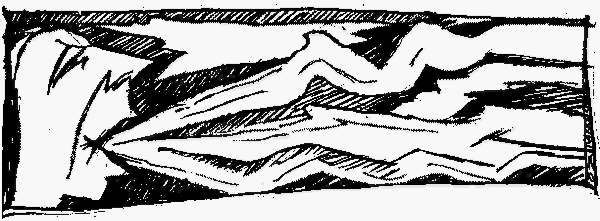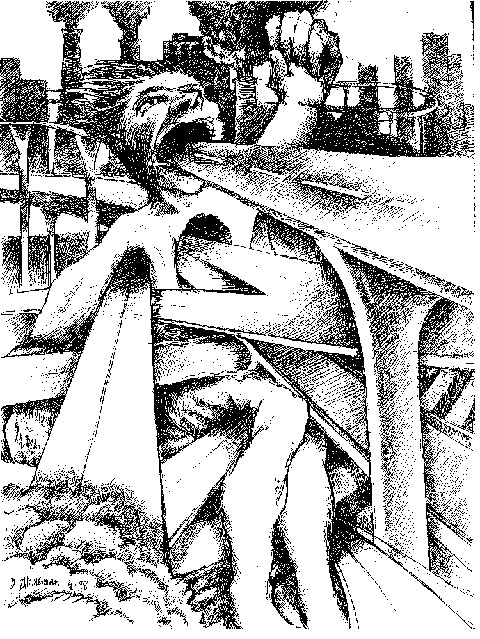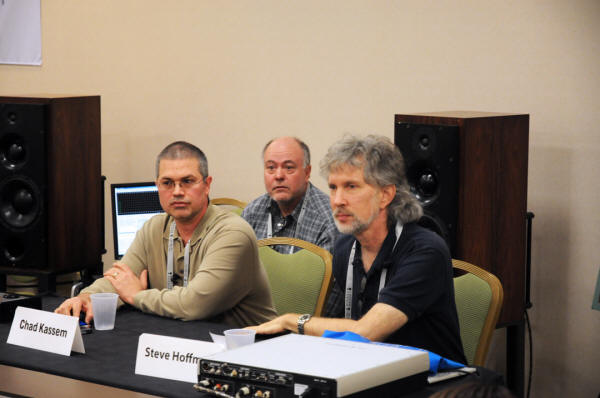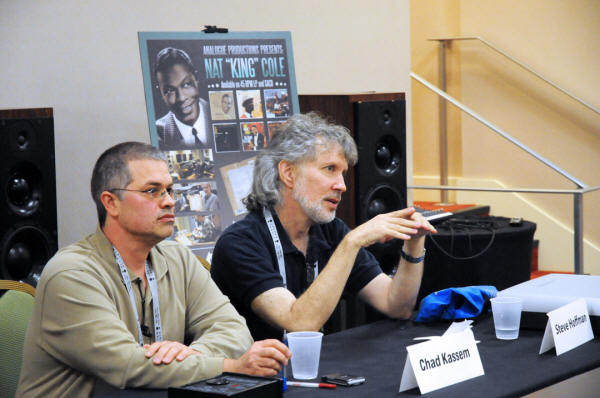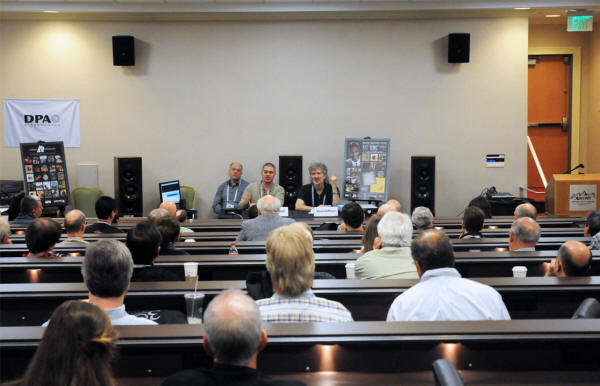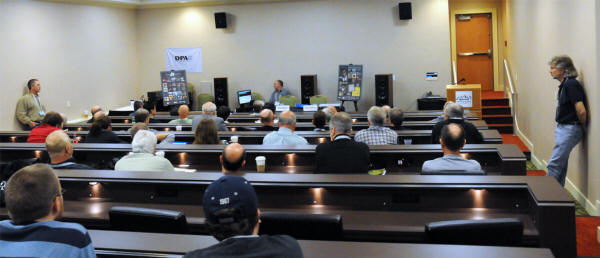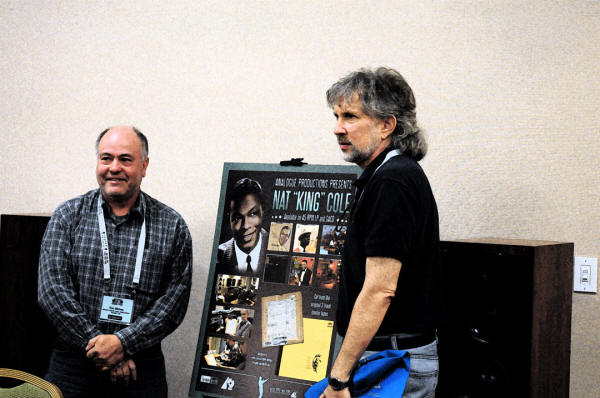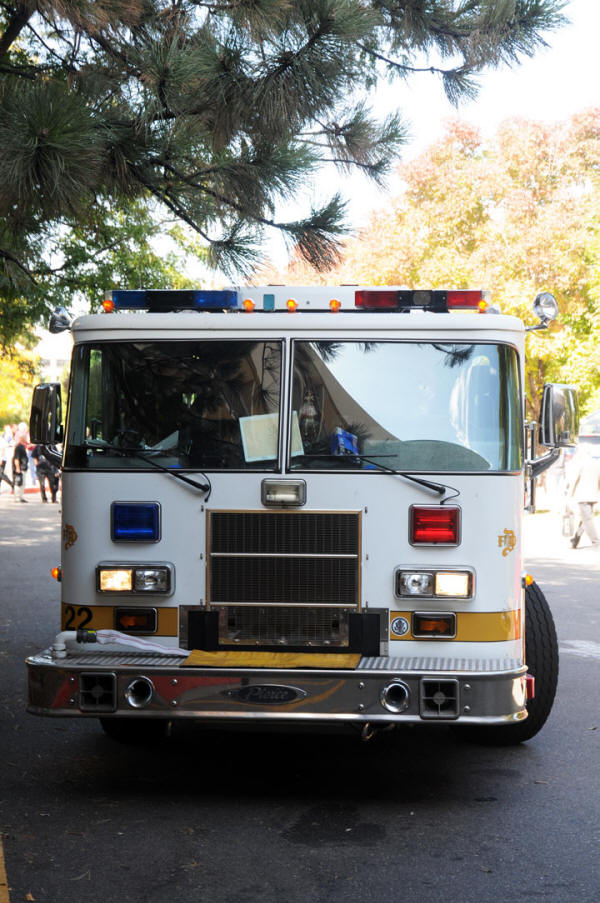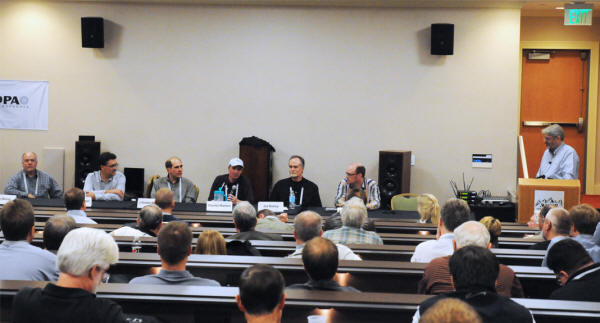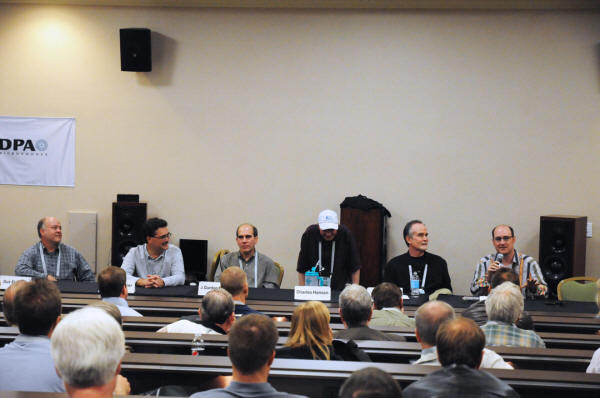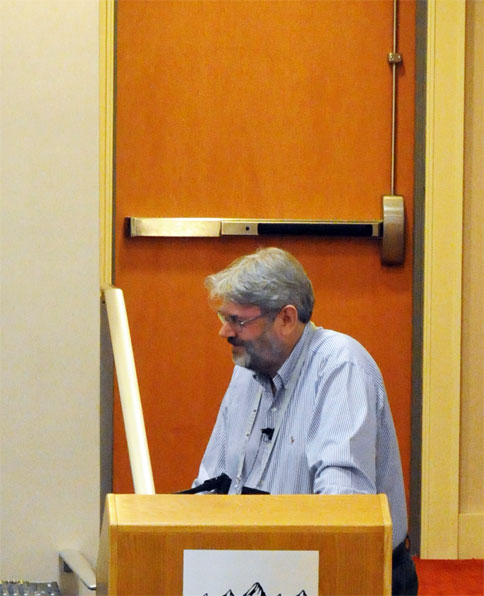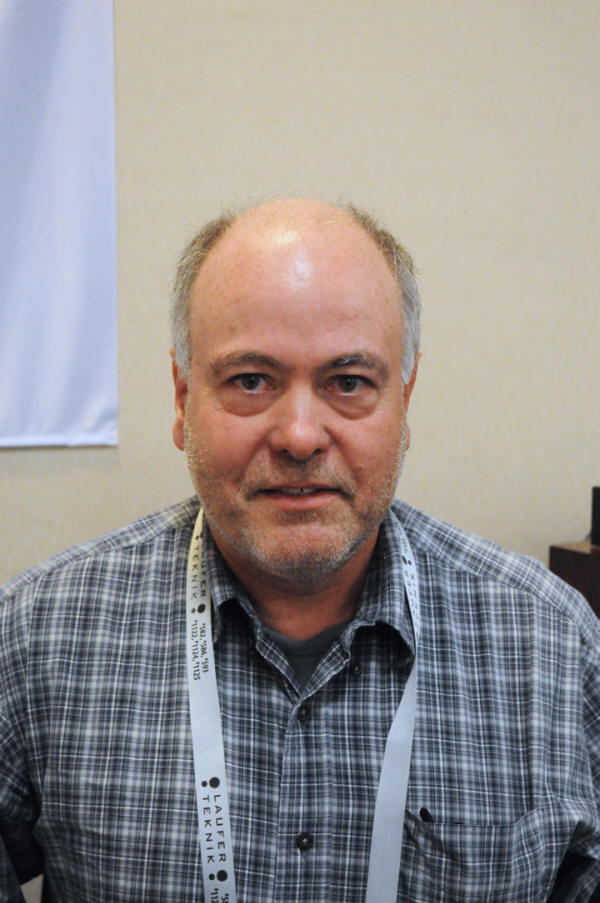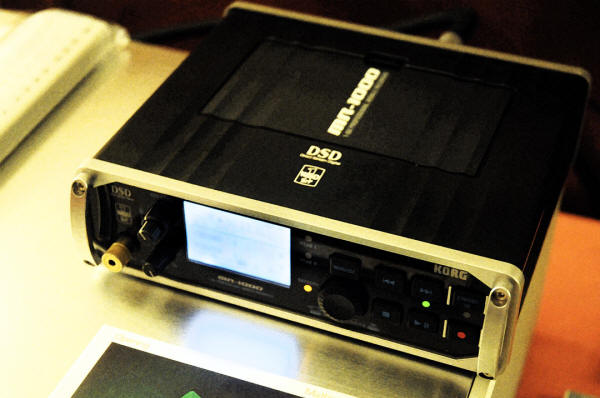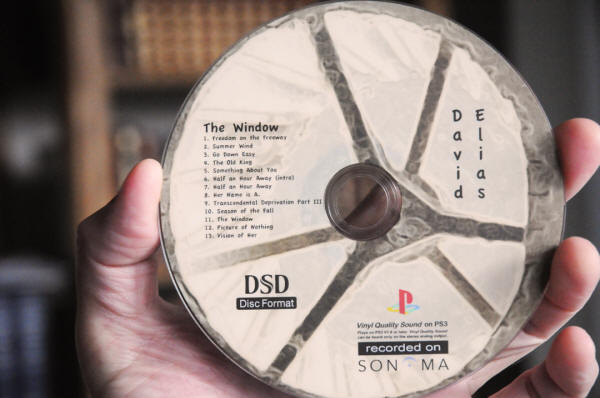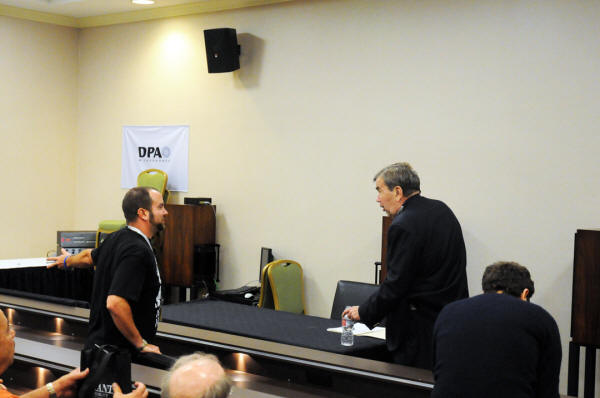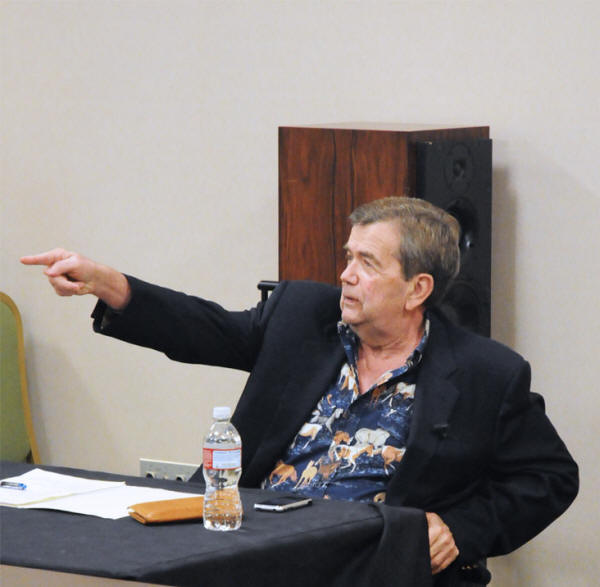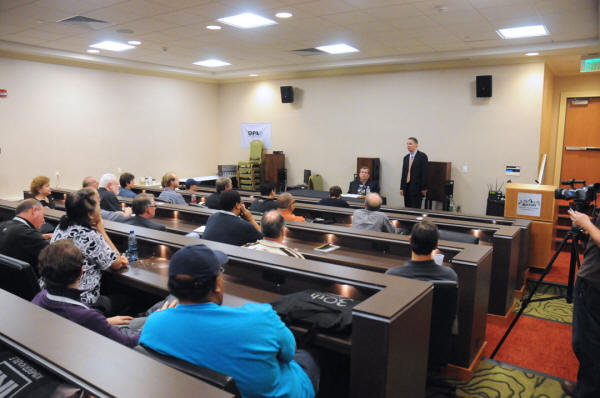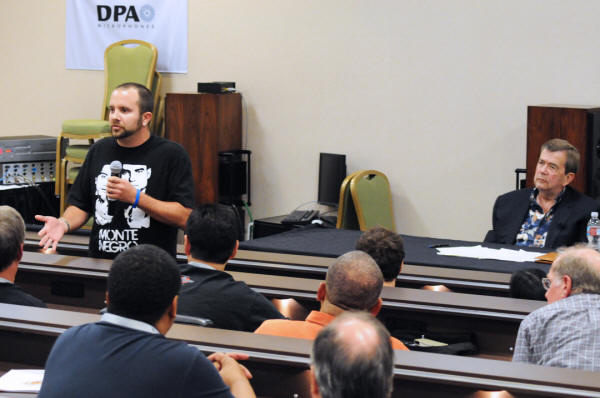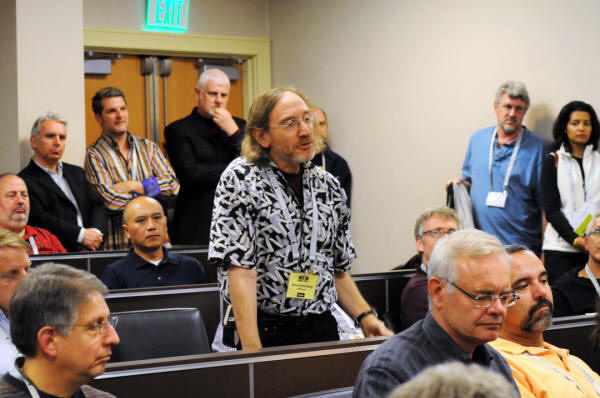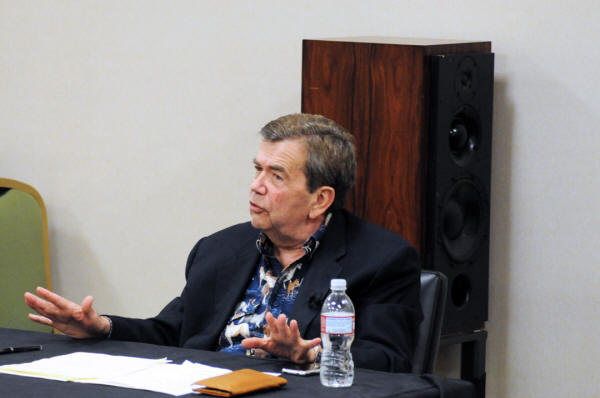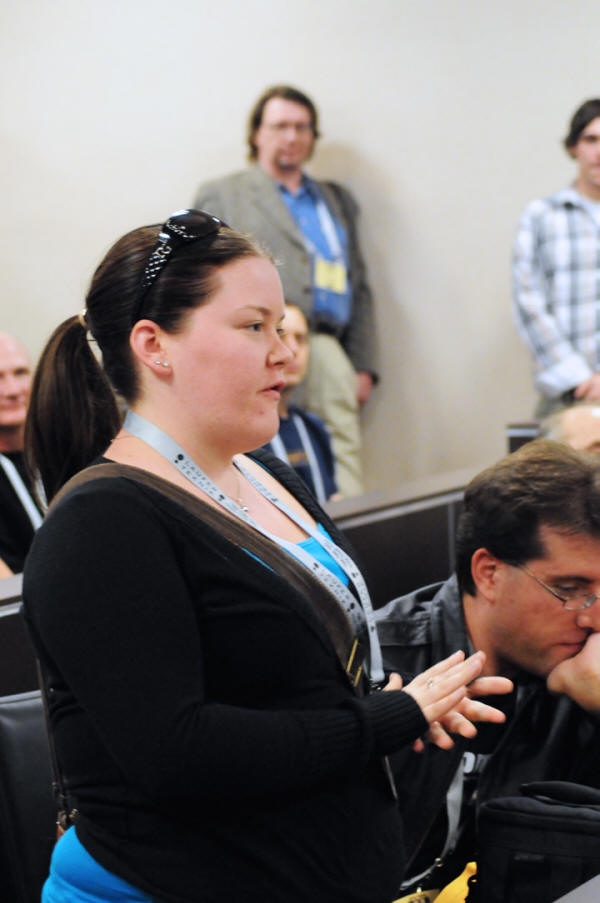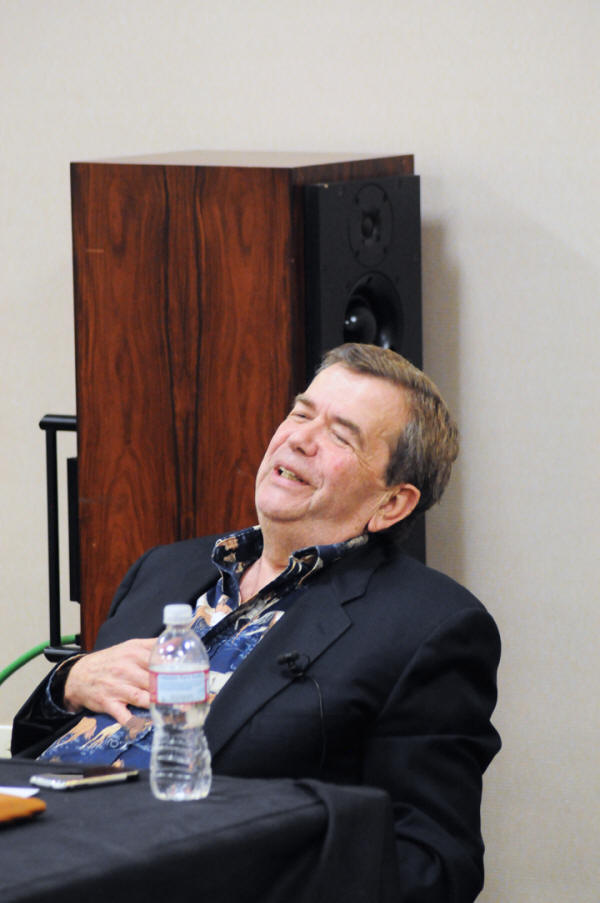|
You are reading the older HTML site Positive Feedback ISSUE 46november/december 2009
Notes from RMAF 2009, Part II: Panels and Presentations, with David W. Robinson
[All photographs and processing by Robinson; cartoons by Dan Zimmerman]
There was more to RMAF 2009 than visiting the rooms and checking out the exhibits and booths. While listening to the gear and meeting audiobuds once again is at the heart of the event, there were some panels and discussions that looked very worthwhile this year. I decided to spend more time than usual attending these events. Good thing, too, as I got to hear some things that were genuinely interesting This year's targets on my attendance list started out with John Atkinson's presentation, "PC Audio – Squeezing the Music Till the Bits Squeak." I attended this presentation because my first impression was that it might cover the sort of grievous lossy compression that various computer-/Internet-based formats have inflicted on us in the name of "convenience," "portability," and "kewl!" The too-small presentation room, a converted nook of Ray Kimber's larger suite (where great music always flows in exceptional DSD), filled up rapidly with audio minions and audiophilions, leaving me trapped in my chair. There I was, feeling vaguely sorry for myself, when John rushed in, set up his notebook and projector, did a debuggery or two to his kit, and then began. As it turned out, John's presentation did not cover what I thought it would, but a completely different topic: that of the much-lamented "volume wars" in audio production. Anyone who's been paying attention to radio playback over the past 25 years or so knows what this is about: compression to the max, to allow the rancid radio station powers-that-be TO GET OUR ATTENTION!!! Red line the production output… hammer the levels…that sort of thing. Television's no better; the shift from program material VU's to commercials can lift one right out of the chair, groping for the remote.
John shared a series of analyses that he had done of some recordings, demonstrating the increases in compression over the past couple of decades. No surprises here; they simply confirmed the dreck that's been inflicted on the airwaves for quite a while now. The good news is that some groups are fighting back, seeking to force a lowering of such practices. The bad news is that none of these groups has any power other than that of public persuasion… which means that I'm highly skeptical that anything will change here in the land of TOO LOUD!! But I appreciated John's attempt to draw attention to the nasty beastie, and couldn't agree with him more on this subject.
Left to right: Chad Kassem, Gus Skinas, and Steve Hoffman My second event was Adventures in Mastering, featuring a presentation by Chad Kassem of Acoustic Sounds/Analogue Productions, Steve Hoffman, and Gus Skinas of the Super Audio Center. I know all three of these gents, and really appreciate the fine work they've done over many years now to produce top-notch recordings and production work. I was late making it to this session, unfortunately, but I did get to sit in on a big announcement: Analogue Productions has secured the rights to, and will be issuing, Nat King Cole on both 45 RPM LP and hybrid multi-channel/stereo SACD.
Chad has assembled his usual team of terrific audio honchos to carry out this project: Steve Hoffman on the mastering, Kevin Gray of RTI on the LP side, and Gus Skinas on the DSD production and SACD authoring part of the picture.
A full house: attendees follow the discussion of SACD and LP reissues with careful attention The room was packed as Chad outlined his plans for eight to nine titles in a Nat King Cole series, with both 45 RPM and SACD versions to be produced. A release date for the series beginning in early 2010 was announced, though firm dates aren't in the can yet.
Listening to Nat King Cole in 3-channel DSD from hard disk… and yes, those are the same three speakers that were used for the mastering. The sound of the DSD playback via EMM Labs multi-channel was simply unbelievable. During part of the session, Gus Skinas played back 3-track DSD masters of some of the Nat King Cole songs that had already been created. The music was played back on the very same three monitors that had been used in the DSD studio sessions. As a long-time Nat King Cole fan, I was knocked out by the amazing quality of the DSD masters. Clearly the 3-track analog masters are in excellent condition, as Gus' playback demonstrated.
Gus Skinas and Steve Hoffman pose next to the Analogue Productions release poster for the Nat King Cole series on 45 RPM LP and SACD Another exciting news flash was that Chad and Analogue Productions were using the "Elvis" word during this session. Titles on 45 RPM LP? That's fine, but what about SACD? Interesting possibilities there…. At this point in time, I don't have more specific information than that, but hope to know more from Chad in the near future. Knowing Chad Kassem's production values and the great team that he uses, I'm quite sure that the results will be spectacular.
"We interrupt this program to bring you this breaking news story…!" Interlude And the power and lights went out. And then the fire alarms went off. And the emergency lights came on. And the sirens went off. And the silly recorded voices blathered mindlessly. And we were not to panic. And we were not to evacuate, or maybe we were. And the fire engine came. And the firemen came. And then the power came back And then they left. And then the power went out again. And then the firemen came back. And then the power came back. And then we went out and had a drink.
The Computer Audio Panel in action: from the left side to the right, Gus Skinas of the SACD Center, John Stronczer of Bel Canto Design, J. Gordon Rankin of Wavelength Audio, Charlie Hansen of Ayre Acoustics, record producer and audio engineer Joe Harley, Chris Connaker of the online publication http://www.computeraudiophile.com, and the moderator, John Atkinson of Stereophile. In among all the ruckus, I was able to sit in on a panel discussion that I found to be quite absorbing. The Computer Audio Panel provided a series of viewpoints about what was happening in the world of computer-based audio. John Atkinson set the tone of the session by making a very strong plea for open standards in computer audio, something that would allow audiophiles and music lovers all over the world to obtain the greatest degree of freedom in pursuing their love of PCM-based recordings via the Internet. Over the course of the panel discussion, Atkinson also had some very positive things to say about DSD, a fact that I noted with interest. Chris Connaker talked about what was current in the world of computer-based music, and showed a great deal of support for Linux-based music servers/music appliances. This would provide maximum support of open standards and freedom via Linux's GPL, and higher levels of quality and reliability. Joe Harley spoke as a veteran analog(ue) man, stating his hope that maximum audio quality and musical values would be preserved as we moved into the very exciting world of computer-/Internet-based audio. (Both Joe and I continue to have an extremely high regard for DSD/SACD, but both were extremely disappointed in the exceptional cluelessness of Sony in grossly bungling the global-level establishment of this standard. Sony Music USA was the real knucklehead in many ways; this is a story that could stand to be told one of these days.)
Charles Hansen and Gordon Rankin talked in turn, and back and forth, about the important work that they've been doing to press forward with USB 2.0 in asynchronous mode as a nearly "jitter-free" pipeline for computer audio. Rankin, a computer programmer with deep experience with the writing of device drivers, has been working on getting asynch mode solid in a driver that would allow all Windows/Mac users to turn their ubiquitous USB 2.0 ports into truly potent music pipes. USB was originally established as a data I/O specification, not an audio pipeline. (This is unlike Firewire, the IEEE 1394 standard, which was designed as a multimedia spec.) By ignoring USB 2.0's synchronous mode, with all of its computer-related fits and starts, and the jitter thereof, and shifting to a buffered asynchronous mode, Rankin claims that USB 2.0 can be made very nearly (completely?) jitter-free. Rankin and Charles Hansen have been working together for several years now to create a USB interface that will work with USB-based DACs connected to home computers/music servers. This would be a very major development, of course. Everybody has USB 2.0 on their computers…unless you have a really, really old computer. Firewire is a great standard, but not very common. AES/EBU is much worse: it doesn't exist at all on any standard computer, and has to be purchased at significant cost and installed. Think "Lynx card." If we could make USB 2.0 behave like a multimedia pipeline instead of a data I/O, a whole new generation of USB-based DACs could hit the shelves very soon. And now that 192kHz/24-bit chips and DACs are becoming more common, a jitter-free asynch USB would remove the single greatest I/O bottleneck standing in the way of higher quality computer audio playback. Significant stuff. Ayre Acoustics has promised PFO one of their USB DACs for evaluation very soon; we'll let you know how it stacks up. Probably the single greatest surprise for me, however, was the news that Gus Skinas shared with us all. And this wasn't just a surprise to me; panel members confessed that they had just heard this bombshell from Gus within a week of RMAF 2009.
Gentleman Johnny A moderates the Computer Audio panel discussion, and well done at that…. Gus had hinted to me that he had a significant announcement just before the panel session started. When it came his turn, he startled me by saying that there was little known "DSD Disc" specification from Sony that would allow stereo DSD Discs to be produced without going through the SACD authoring/mastering system! Any Sony PS3 would play them as pure stereo DSD via the analog left/right RCA outputs using the PS3 RCA adapter! DSD-equipped Sony Vaios, too! Which meant that there was already an installed base of tens of millions of DSD Disc players! Not only that, but DSD Disc files were stored as ISO image files, and could be transported over the Internet (!!) and burned to DVD on any computer for playback on a local PS3(!!!) Apparently this has been a subset specification of the PS3 all along, but—unbelievably—Sony hasn't publicized it to either the industry or the general public. I am sorely… sorely, sorely...tempted to weld "completely clueless" to "Sony," but no, I'll resist.
Gus Skinas of the Super Audio Center: this was a man with some significant news…. Amazing! After all these years of DSD being presented as a locked-down, non-transportable format and specification, incapable of downloading/burning, we were suddenly being told that there was a way to get stereo DSD punted about the planet in a very open-source friendly manner. Sonoma workstations/toolsets or their equivalent are not outrageously expensive, but they do cost enough to keep many labels from acquiring them. And the cost of having DSD masters from various DSD recording systems (e.g., Sonoma, dCS, Tascam, Genex, Pyramix, and Korg) produced can be likewise daunting in these days of tight budgets and general cluelessness in the music biz. It's definitely overkill for most of the Indies, who might be mightily impressed by the musical quality of DSD (if they've heard it… most have not), but can only afford the cheap tools of PCM, with all the sonic limitations of lower resolution PCM. But with DSD Disc, an Indie could easily roll into, say, a Korg MR-1000, record DSD at either 5.6 mHz or 2.8224 mHz, and then go directly to stereo DSD on DSD Disc format, or distribute them via download on the Internet. Very spiffy!
A fresco of the Korg MR-1000 DSD recorder with integrated hard disk, supporting either 2.8224 mHz or 5.6 mHz sampling rates: very compact… DSD on the go! MA Recordings has been using the MR-1000 for its recordings recently, with spectacular results. Needless to say, DSD Disc had caused a bit of a stir among the panelists. DSD in ISO, transportable over the Internet… supreme audio quality, with the ability to be handled on computers? This is really something. Will it develop legs in the marketplace? Good question. Charles Hansen said that while it would not be trivial, it would be possible to re-program the Ayre DAC to handle DSD, since DSD capability is embedded in its chipset. Once that was done, a simple firmware update would deploy the improvement. This would liberate audiophiles from their PS3s, and allow them to process stereo DSD via an asynch USB pipeline with a master clock, ensuring near-zero (perhaps actual zero?) jitter, instead of having to use AES/EBU or ST glass I/O. And that, chilluns, would be quite the accomplishment.
Yep, it's real: the sample DSD Disc of David Elias' The Window… plays just fine on the PS3! This could allow DSD to enter the world of open standards and Internet/DVD burnable, without a doubt. By the way: Gus gave me a sample DSD Disc…nothing less than David Elias' brilliant recording, The Window. I took it home and tried it right out on my PS3; it worked like a charm! All that you have to do is load the disc, go to the Music menu, and you'll see an icon labeled "DSD Disc"; click on it, and the tracks will load. Click on the first track, and away they go. Note: even PS3s that don't support SACD playback (like the one I have) WILL play DSD Discs. And here's another interesting fact, one that Gus didn't know until I told him: My PS3 output the DSD Disc via HDMI as well as the analog outputs. When Gus and I talked about this, he was surprised that the HDMI audio output was working with the DSD Disc, but was sure that the output was DSD converted to PCM. HDMI does not necessarily convert DSD to PCM…there are several player/processor tandems that do handle bitstream via HDMI… but I'd agree with Gus that the PS3 is not doing this. Since there's no problem using the analog stereo RCAs to get DSD quality…simple will be better at this point when dealing with PS3s…we can go with it. There are already some folks exploring DSD Disc support, including Ayre Acoustics, Oppo Digital, MA Recordings, and the Super Audio Center. Korg ought to become aware of this, as well. I've already received samples of DSD Discs from Todd Garfinkle of MA Recordings that sound absolutely terrific, so there is encouraging real world progress here. Todd may even be willing to sell you a sample DSD Disc if you bug him… of course, he still has a few copies of his stellar SACD sampler, MA on SA, which you simply must get if you love SACD. Check out his website at http://www.marecordings.com. I'll keep you informed about DSD Disc as I know more… stay tuned. The last presentation that I caught was Harry Pearson talking about The High End: Past, Present, Future. Given the title, I wasn't going to miss it…I was curious to get his grand view of fine audio (my term, not his).
Just prior to his presentation, Harry (right) talks with Positive Feedback Online's Mike Mercer.
Maestro Pearson makes a point. The past: Pearson started out by praising the work of the late J. Gordon Holt in establishing the foundations of fine audio back in the 1960s. Holt's early work in creating the terminology for subjective audio reviewing was crucial, in Pearson's view. Having grown up reading Holt's Stereophile, Pearson would become passionately interested in audio journalism himself, establish The Absolute Sound, and would build upon the concepts that Holt pioneered. HP's list of great recordings, his extension of terminology and concept, and his ability to describe nuance in meaningful ways contributed significantly to the development of fine audio, even as Holt lost control of Stereophile by its sale to Larry Archibald in the 1980s.
Harry Pearson's second presentation on Saturday afternoon was well attended. The Present: Pearson then went on to talk about the current picture in fine audio. The proliferation of formats, the substantial changes in music distribution and audio publishing were touched upon. TAS is clearly not the same publication that it was in the days when Pearson was the Editor, a fact that Pearson was not able to disguise. Nor was he able to disguise his lack of enthusiasm for the current direction of TAS, in response to a direct question from an attendee. He hinted that "something" different might be under development, but provided no details as to what that might be.
PFO's Mike Mercer speaks about the future of fine audio, and the need for dealers to reach out to the younger generation of iPhone/iPod, MP3, and computer-based audio and music lovers. The Future: HP was emphatic. The future of fine audio reproduction was DSD, and surround sound in our listening rooms. I couldn't agree more, naturally, since I came to this conclusion back in 1998/1999, and have published that conviction from that time to this. Harry invited Positive Feedback Online's Mike Mercer to speak briefly on the new generation of music and audio lovers. Equipped not with turntables and optical disc players, but with iPhones, iPods, MP3 players, computers, and music servers, this nextgen of audio consumers were different in equipage, but no less passionate about having and playing with their music. Audiophiles are missing a golden opportunity to reach out and evangelize these listeners to the possibilities of fine audio, but the moment is not lost. Certainly we at PFO have been covering these developments with real interest over the past few years, and have devoted space and effort to computer-based audio in our pages.
Steve Guttenberg questions Harry Pearson during Q&A at his presentation. During a brief time for Q&A there were questions from the audience. Did Pearson's vigorous espousal of DSD and surround sound mean that he was no longer passionately attached to his LPs and turntable?
Uh… NO! (This is a view that I share with Pearson; why do we always descend to this sort of either-or thinking? Loving DSD/surround sound does not mean that I must abandon LPs, eh?)
What about his relationship to TAS? Well, perhaps "something new" would come along. In fact, this is where Pearson spent some time hinting that a major prospect was in the works. Was Pearson just being coy… not an uncommon thing, by the way… or is he really looking to break some new ground? Frankly, unless HP is willing to be more collaborative and associative than heretofore, I'm not sure what that new direction might be.
Then again, I certainly do not know. Harry knows how to reach me if he'd like to escape the rut and do "something completely different." (With apologies to Monty Python!) All in all, the seminars and panel discussions at RMAF 2009 proved to be very worthwhile. I had hated to give up the exhibitor room time, but came away with some real grist for thought. I extend my thanks to all who were involved in these four sessions, and who provided such informative and thought-provoking dialog. If you missed RMAF 2009, you really should do yourself the favor of attending RMAF 2010. You won't regret the trip!
|

